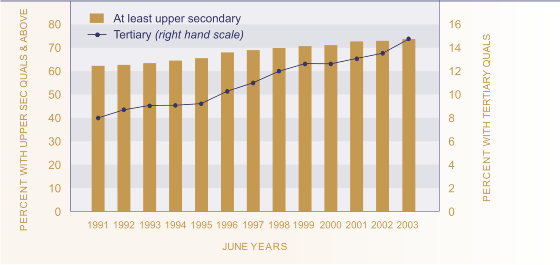Relevance
The educational attainment of the adult population is an indicator of the skills available in the economy. The level of formal educational qualifications in the population is a commonly used proxy for the stock of 'human capital' ie the skills available in the population and labour force.
Current Level and Trends
At June 2003, 74 percent of the population aged 25-64 years (1.5 million people) had attained an educational qualification of upper secondary level or above. This proportion has steadily increased from 62 percent in 1991. Over the same period the proportion of adults with a Bachelor's degree or higher qualification has risen from 8 percent to 15 percent (297,000). While some of the increase is due to adults gaining additional qualifications, most of the upward trend is due to new entrants to the 25-64 age group (young people and migrants) being better qualified on average than people reaching retirement age.
Figure K3.1 Proportion of adults aged
25-64 with educational achievement of at least upper secondary level
and tertiary level, 1991-2003

Source: Statistics New Zealand,
Household Labour Force Survey
Note: Tertiary = Bachelor's degree or higher
Age and Sex Differences
Younger adults aged 25-34 years are much more likely to have at least upper secondary school qualifications than adults aged 55-64 (79 percent, compared to 61 percent). Similarly, young adults are more likely than older people to have tertiary qualifications (18 percent, compared to 9 percent).
Sex differences in educational attainment have narrowed over time. In 2003, women were more likely than men to have higher educational qualifications at ages 25-34. In contrast, at older ages men are much more likely than women to have higher educational qualifications.
Table K3.1 Proportion (%) of population aged 25-64 with higher qualifications, by age and sex, 2003
| 25-34 | 35-44 | 45-54 | 55-64 | Total 25-64 | |
|---|---|---|---|---|---|
| At least upper secondary | |||||
| Males | 78.7 | 77.9 | 75.3 | 66.2 | 75.3 |
| Females | 80.2 | 76.5 | 70.8 | 55.4 | 72.3 |
| Total | 79.5 | 77.2 | 73.0 | 60.8 | 73.7 |
| Tertiary | |||||
| Males | 17.1 | 17.0 | 16.3 | 12.0 | 16.0 |
| Females | 19.2 | 14.6 | 12.3 | 6.3 | 13.8 |
| Total | 18.2 | 15.8 | 14.3 | 9.1 | 14.8 |
Source: Statistics New
Zealand, Household Labour Force Survey
Note: Tertiary = Bachelor's degree or higher
Ethnic Differences
Māori and Pacific adults are much less likely than European and Other ethnic groups to have higher qualifications. In the year ended June 2003, 62 percent of Māori and 50 percent of Pacific adults aged 25-64 held upper secondary qualifications, compared to 78 percent of Europeans. Similarly, just 6 percent of Māori and 7 percent of Pacific adults held a tertiary qualification at Bachelor's degree level or above, compared to 15 percent of Europeans. However, since 1991, growth in the proportion of adults with higher qualifications was fastest among Māori and Pacific adults.
The growth in the proportion of Pacific peoples with higher qualifications reflects the increasing proportion of the Pacific population who are born and educated in New Zealand. The relatively high percentage of the 'Other' ethnic group with higher qualifications reflects the selective process of immigration, which tends to target those with higher qualifications.
Table K3.2 Proportion (%) of population aged 25-64 with higher qualifications, by ethnic group, selected years, 1991-2003
| European | Māori | Pacific | Other | Total | |
|---|---|---|---|---|---|
| At least upper secondary | |||||
| 1991 | 66.1 | 39.3 | 27.9 | 57.7 | 62.3 |
| 1996 | 72.2 | 47.4 | 38.1 | 59.9 | 68.0 |
| 2002 | 76.9 | 59.6 | 49.8 | 67.5 | 73.0 |
| 2003 | 77.6 | 62.3 | 50.2 | 67.5 | 73.7 |
| Tertiary | |||||
| 1991 | 8.4 | 1.3 | .s | 19.7 | 8.0 |
| 1996 | 10.4 | 2.3 | 2.2 | 27.1 | 10.2 |
| 2002 | 13.5 | 5.5 | 5.8 | 31.5 | 13.7 |
| 2003 | 14.6 | 6.0 | 7.4 | 32.2 | 14.8 |
Source: Statistics New
Zealand, Household Labour Force Survey
Note: .s = sampling error too high for publication; Tertiary =
Bachelor's degree or higher
International Comparison
In 2001, 76 percent of New Zealand adults had at least upper secondary level qualifications, compared with an OECD median of 67 percent.35 New Zealand ranked 12th out of 30 OECD countries. New Zealand also ranked 15th (equal with Ireland and Hungary) in the proportion who have completed tertiary qualifications to Bachelor's degree or higher, with a rate of 14 percent (the same as the OECD median). Countries which had higher proportions of adults with tertiary qualifications at this level included the United States and Norway (both 28 percent - the highest rate), Canada (20 percent), Australia (19 percent), and the United Kingdom (18 percent).
